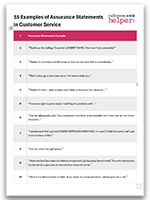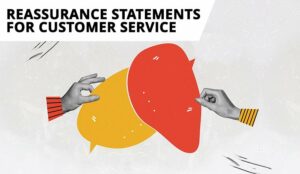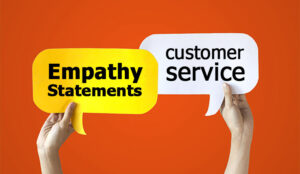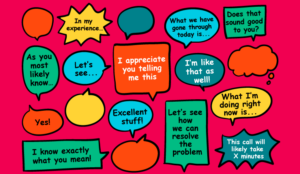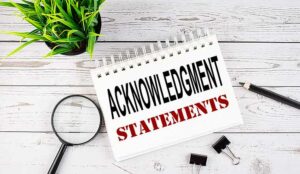When a customer has a problem, their anxiety builds. By using assurance statements, advisors help them move away from such negative emotions.
After all, managing emotion in customer service does not have to be complicated. These phrases offer a simple but effective option to support customers – when applied to an appropriate scenario.
What is an Assurance Statement?
An assurance statement in customer service helps put customers at ease by assuring them that the agent is fully committed to resolving the issue at hand, building trust and confidence throughout the conversation.
By using clear, empathetic language, agents can express confidence in finding a solution, which not only alleviates customer anxiety but also encourages a cooperative relationship.
Effective assurance statements foster a sense of security, helping customers feel more confident in the agent’s ability to resolve their problem, and ultimately improving the overall customer experience.
10 Examples of Assurance Statements for Customer Service
Here are the top ten assurance statements to enhance customer service and put your customers at ease.
1. “Thank You For Calling. My Name Is [INSERT NAME]. How Can I Help You Today?”
This greeting reassures the customer by personalizing the interaction and confirming their connection to the right representative.
It also signals readiness to assist, making the customer feel valued and confident in receiving support or information.
2. “Thanks For Alerting Us To The Issue So That We Can Deal With It Immediately.”
An advisor can offer reassurance to a customer that they recognize the urgency of their issue by using the statement above. It will also hint that the company is quick to solve such queries.
As such, the advisor subtly assures the customer that they will experience little future hassle while praising them for taking the best possible action by phoning in.
3. “That’s Okay, Go At Your Own Pace. I’m Here To Help You.”
Anxious customers often struggle to hide their apprehension. If an advisor can assure them that there is no rush, it paves the way for customers to think more clearly.
A technique of this nature is excellent when dealing with vulnerable customers and may also reduce handling times in a customer-friendly manner.
Finally, when an agent uses the words “I’m here to help you,” the customer gains the reassurance that they are on the line with a capable person.
4. “Thanks For That… Just To Make Sure I Fully Understand The Situation…”
Using a phrase like this allows advisors to summarize the problem back to the customer. Doing so assures them that the rep understands their issue and offers the chance to add important information that the advisor may have missed.
To support this approach, Carolyn Blunt, a customer service expert, recommends: “Taking all the information that the customer has given us and drilling down on that with clarifying questions.” After asking these, the advisor can better summarize the issue and reassure the customer.
Discover many more questioning techniques to enhance customer service in our article: 6 Effective Questioning Techniques for Customer Service
5. “You Were Right To Get In Touch. I Will Flag The Problem With…”
When handling a complaint, listen closely, and assure the customer that they were right to get in touch. By doing so, the company appears attentive and open to feedback.
Highlighting that they will also flag the issue with senior management perpetuates this notion, while – following this statement – a gesture of goodwill is also a nice bonus.
6. “You Are Absolutely Right. Your Experience Has Been Unacceptable. Let’s See How We Can Move Forwards…”
Telling the customer that they are right conveys the impression that the advisor is on their side. The word “absolutely” adds emphasis to this point. Other words that end in “-ly”, including “certainly”, “definitely”, and “completely” also help to build impetus.
To further show support to the customer, acknowledge that their experience was “unacceptable” before refocusing the conversation towards the positive: the solution.
7. “I Understand That You Feel [INSERT EXPRESSED EMOTION]. I’m Sure I’d Feel The Same. Let’s Get To The Bottom Of This!”
By recognizing the emotions that customers express, advisors may assure them that they are listening while showing empathy at the same time.
Adding the sentence “I’m sure I’d feel the same” builds this empathy further while it assures the customer that their emotional response is not only natural but relatable too.
The final clause moves the conversation forwards to avoid dwelling on the negative now the advisor has offered assurance.
8. “You’ve Called The Right Place.”
Giving customers compliments – no matter how small – makes them feel good about themselves. Such positive emotion is integral to good customer experiences. Telling customers that they have done the right thing is an excellent example.
Also, this statement helps to build customer confidence in the advisor, providing assurance as to their ability. Such assurance brings many benefits as the call continues.
9. “I Have Booked [AN ENGINEER/DELIVERY/INSPECTION] At This Time [INSERT TIME]. They Will Contact You [At This Time] To Give You An Idea Of When They Will Arrive.”
Summarizing the call’s outcome and signposting what happens next assures the customer that a resolution is near.
Giving them this peace of mind helps bring the call to a positive conclusion, ending the service experience in a high.
For more great advice on how to end the call on a positive note, read our article: The Top 10 Call-Closing Statement Examples
10. “Here Is My Direct Phone Number. If You Have Any More Problems, Please Give Me A Call.”
Offering a direct number to customers dealing with challenging queries gives them the sense that they have their own personal assistant.
Also, when the customer calls back, there is no need to repeat themselves as the advisor will likely have some recollection of their previous conversation.
Alongside this statement, perhaps remind the customer of the contact centre’s opening hours. Doing so will avoid any future disappointment in failing to reach the advisor.
Printable – 10 Examples of Assurance Statements in Customer Service
Do you want to download this to share with your team?
Get your free download of 10 Examples of Assurance Statements in Customer Service now:
Why a Positive Attitude Matters
Assurance statements remove worry. Such nervousness is often at the root of many challenging customer emotions, including anger, indecision, and confusion.
However, while an assurance statement will likely prove helpful, it is no silver bullet. Without an upbeat tone to accompany such a phrase, the impact on improving customer emotion lessens.
Remember: positive energy is infectious.
Old school advice, such as “smile as you dial” works well here. But coaching advisors to manage their emotional response and avoid defensiveness is even better. Doing so is a skill which will improve the agent experience as they learn to avoid taking customer frustration to heart.
As such, advisors are more likely to keep hold of their positive energy. They will naturally use positive words in their conversations to win more customers over.
Eager to learn more words and phrases to enhance your customer service vocabulary? The following articles contain a few of our favourites:
- Top 25 Positive Words, Phrases and Empathy Statements
- Customer Service: 50 Nice Words to Say to Someone
- 27 Positive Statements to Use in Difficult Situations
Author: Charlie Mitchell
Reviewed by: Robyn Coppell
Published On: 22nd Jun 2022 - Last modified: 13th Oct 2025
Read more about - Customer Service Strategy, Call Handling, Carolyn Blunt, Charlie Mitchell, Editor's Picks, Free Downloads, Handling Customers, Language, Positive Words, Service Strategy







